Book Review: Flash Gordon Book Four: Forces from the Federation by David Hagberg
At long last, Colonel Steve “Flash” Gordon and his companions Dr. Hans Zarkov and Dale Arden are headed home in their refurbished starship, the Intrepid. They’re looking forward to briefing the Federation government about their adventures fighting the android robot warlord Martin and bringing a ceasefire to the advanced civilization of Centrus. Then they can finally relax on Earth for a while. Flash does want to avoid dealing with Trans Federation, the most powerful corporation in human space, as they no doubt consider Flash and his friends as thieves for disappearing with the alien ship that set off this entire sequence of events. As soon as the Intrepid enters the Solar System, however, they’re fired upon by a Federation vessel!

It turns out that the Federation is on a war footing. A detachment of Martin’s fleet had come into human space and wreaked havoc until Trans Fed came up with weapons to stop them. In this emergency, Trans Fed was given control of the Federation military and declared martial law. Although there have been no new attacks in some months, martial law has not been lifted. Flash and company are taken prisoner and shipped to Trans Fed’s Mex-Tex headquarters in Dallasworth.
There, the secret of Centrus’ location is obtained from them by illegal mind probes, and they learn that T. Roland McManus, president of the board of directors of Trans Fed, plans to send a war fleet to the technically advanced but exhausted world to capture it and make Trans Fed sole ruler of known space. McManus’ overconfidence allows the prisoners to escape, but now they somehow need to get in contact with the civilian government to reveal the corporation’s treachery!
This is the fourth of six books in a series that “reimagines” the classic science fiction franchise, which came out about the same time as the 1980 movie. Only the names and rough outlines of the main trio of characters are kept, with no Emperor Ming, Planet Mongo or Hawk Men. In this version, Flash is somewhat older than usual, a widower with a tragic past and an experienced military man. Doctor Zarkov is a respectable and rather frail scientist, and Dale is his niece. It’s only now in Book Four that Flash and Dale are admitting they are in love with each other.
Good: This story has pulp roots, and quickly shifts from one exciting action sequence to another with only brief interludes for our heroes to get a little sleep and food. Flash wins many individual fights, but the scope of the problem keeps them on the run, and this volume ends with a development that makes things even worse! (We are, after all, only on part 4 of 6 in this serial.)
Less Good: In this volume, Flash is practically a solo hero. He goes alone into dangerous situations while the others are incapacitated several times. Dr. Zarkov does science stuff in the background when he isn’t busy being frail, and Dale spends most of her awake time tending to her uncle or the random child the trio acquires about halfway through.
Also, while enough is explained of the previous events eventually for the sharp reader to catch up, the author does presume you’ve read the earlier volumes and the casual reader looking for something closer to the old comic strips or serials might bounce off.
Content note: A minor character is revealed to be an abusive spouse and parent after their death.
Overall: I’ve certainly read worse Flash Gordon stories. It’s actually pretty good in its own right, but tends to be a Flash Gordon book only in name and probably wouldn’t have sold if it wasn’t tied to the franchise. You might want to see if you can track down the entire series for cheap because I’ve heard that as an entire story it’s pretty awesome.

